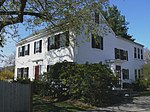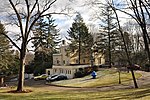Edmund Parker Jr. House
Houses on the National Register of Historic Places in Winchester, MassachusettsWinchester, Massachusetts Registered Historic Place stubs

The Edmund Parker Jr. House is a historic house in Winchester, Massachusetts. The 2+1⁄2-story wood-frame house was built c. 1826, and is one of a few transitional Federal-Greek Revival houses in the town. It has the typical Federal plan of five bays wide and two deep, with a center entry framed by a Greek Revival portico. The house was built by Edmund Parker Jr., whose father was one of the first settlers in the area.The house was listed on the National Register of Historic Places in 1989.
Excerpt from the Wikipedia article Edmund Parker Jr. House (License: CC BY-SA 3.0, Authors, Images).Edmund Parker Jr. House
Cambridge Street,
Geographical coordinates (GPS) Address Nearby Places Show on map
Geographical coordinates (GPS)
| Latitude | Longitude |
|---|---|
| N 42.456111111111 ° | E -71.159722222222 ° |
Address
Cambridge Street 287
01890
Massachusetts, United States
Open on Google Maps










